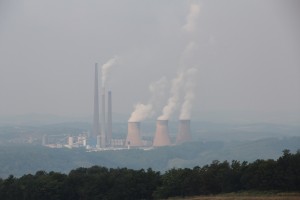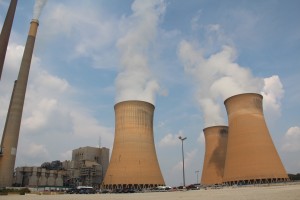Federal air rules force coal plants to clean up or shut down
-
Reid Frazier/The Allegheny Front
John and Maureen Vilcek have lived exactly one mile from the coal-fired Homer City Generating Station in Indiana County, Pa. since the 1970s.
They raised their children here, and hardly notice the constant rumble emanating from the plant up the road.
“I’d much rather it be coal-fired than nuclear,” Maureen Vilcek said. “In the beginning, there was some fly ash we dealt with, but that went away in the first few years.”
Though the Vilceks say the plant has cleaned up, it’s still a big polluter. Homer City was recently ranked the top emitter in the country for sulfur dioxide. Even so, Maureen Vilcek doesn’t want it shut.
“That’s a lot of the economy of this region,” she said. Coal truck drivers, power plant workers, and local coal mines have depended on this plant for decades. “I would hate to see something happen to this power plant.”
DOUBLING DOWN ON COAL
Her worries about the plant’s future are well-founded. Around 200 coal-fired power plants have either closed or announced plans to shut down around the country. Cheap power generated with natural gas has made coal-fired electricity less competitive. But federal clean air rules are also forcing plants to make a choice: clean up—or shut down.
Homer City is cleaning up. James Shapiro of GE Energy Financial Services, which owns the plant, said GE has been installing two enormous scrubbers to clean up the exhaust from its power plant. The total will run around $1 billion, and will reduce its sulfur dioxide emissions–key components of unhealthy soot pollution–by 98 percent.
“We decided it was more prudent actually to go forward with this investment and ensure the ongoing existence of the station,” Shapiro said. The plant is paying for these upgrades because of a series of rules the EPA has implemented under the Obama administration. These include the 2011 Cross State Air Pollution Rule (CSAPR) and the 2012 Mercury and Air Toxics Standards (MATS), which required coal plants to reduce mercury, harmful gases and particulate pollution. MATS was struck down by the Supreme Court earlier this year, which sent it back to EPA for a re-write because the agency hadn’t considered the cost of implementing it. The Court also sent CSAPR back to the EPA for a re-write because it ruled the agency went too far in policing emissions from power plants. But these decisions came after Homer City and other power plants had to choose whether to comply with it or not.

Reid Frazier / StateImpact Pennsylvania
Homer City was ranked among the biggest polluters of sulfur dioxide in the nation.
Building the scrubbers to comply with MATS and other regulations is a heavy undertaking, says Todd Kollross, one of Homer City’s engineers. The scrubbers have to be custom-built on site and are not a one-time expense. Some materials used to take pollution out of the coal plant’s exhaust must be replaced periodically. Kollross says the decision by GE to build the pollution controls mean the company was doubling down on Homer City.
“They’re banking on the plant, and if we didn’t put it in, the plant won’t run,” says Kollross. “So it was either you had to do it, or you were done.”
COAL CUTS ITS LOSSES
But not every plant owner is willing to plunk down big money to keep pace with the EPA’s new air rules. In 2013, FirstEnergy announced it would close the Hatfield’s Ferry and Mitchell power plants near Pittsburgh. Stephanie Walton, a spokesperson for FirstEnergy, says the cost of compliance with MATS became too much—especially since the plants were already struggling to compete with electricity generated from cheap natural gas and a sluggish power market.
“The plants were both losing money,” she says. “And that was a result of—at the time—current and projected economic conditions [of] low-cost electricity and low demand for electricity.”
FirstEnergy decided to put pollution controls on its six remaining coal-fired power plants in Ohio, West Virginia and Pennsylvania. Even though the prior owner of Hatfield’s Ferry had already put $700 million in pollution controls into the plant, FirstEnergy decided to cut its losses after the EPA announced the mercury rules.
AIR RULES: ‘WAR ON COAL’?
For some, these closures are evidence that the federal government is pushing the coal industry too far.
“Some people call it—and I would tend to agree with them—a war on coal-fired power plants,” said Joe Duckett, an environmental engineer who’s watched the industry for 35 years.
Duckett, a member of the Pennsylvania Department of Environmental Protection’s (DEP) Air Quality Technical Advisory Committee, says coal has been an easy target for regulators.
Unlike a steel mill, a power plant can’t be moved overseas if regulations make it more expensive to operate. If the plant has to add new scrubbers, those costs get passed on to ratepayers. He thinks the EPA regulations are unfairly forcing coal companies to spend billions of dollars for increasingly small improvements to air quality. He points to Pennsylvania’s air quality, which has generally been improving in recent years.
“When you get down to some of the levels we’re now regulating, it is arguable how much bang for the buck you get,” he said.
But environmentalists say the pollution controls like the kind Homer City is installing are necessary.
“On an annual basis, the pollution from Homer City results in 250 premature deaths, 420 heart attacks, 3,900 asthma attacks and 190 other types of hospital admissions,” said the Sierra Club’s Tom Schuster, part of the club’s “Beyond Coal” campaign.
The EPA says particles like the kind Homer City emits kill thousands of people a year, and the plant’s new scrubbers will keep much of this pollution from pouring into western Pennsylvania skies. Schuster says if coal wants to compete with other types of energy, it will have to do it cleanly.
“Coal can be clean, and coal can be cheap. But it can’t be both at the same time,” he said.
And it will only get harder for coal, Schuster says. The EPA’s new climate rules target that other harmful byproduct of burning coal—climate-altering carbon dioxide. Plant owners say they’re not sure what they’ll have to do to keep up with that new rule.

















